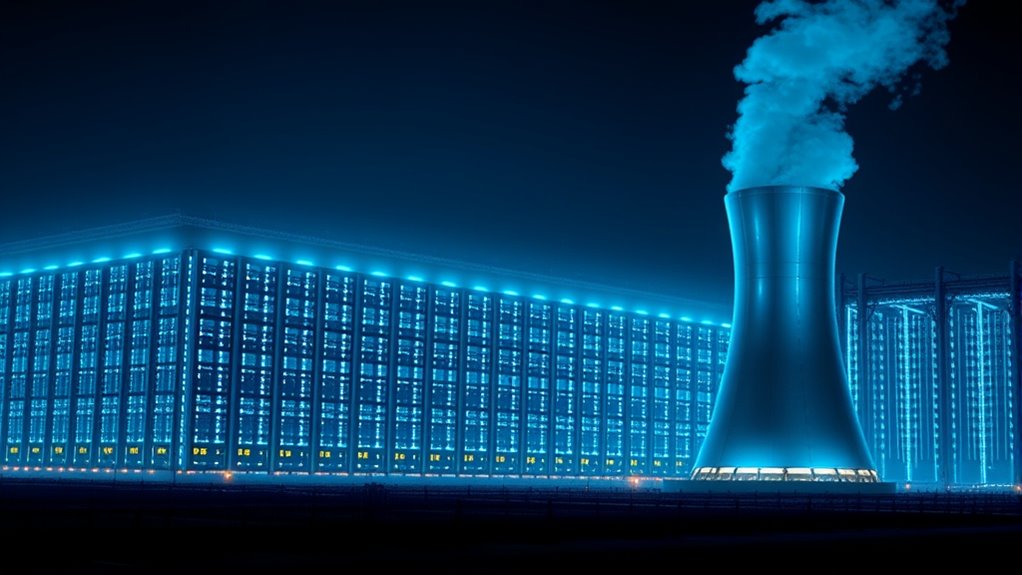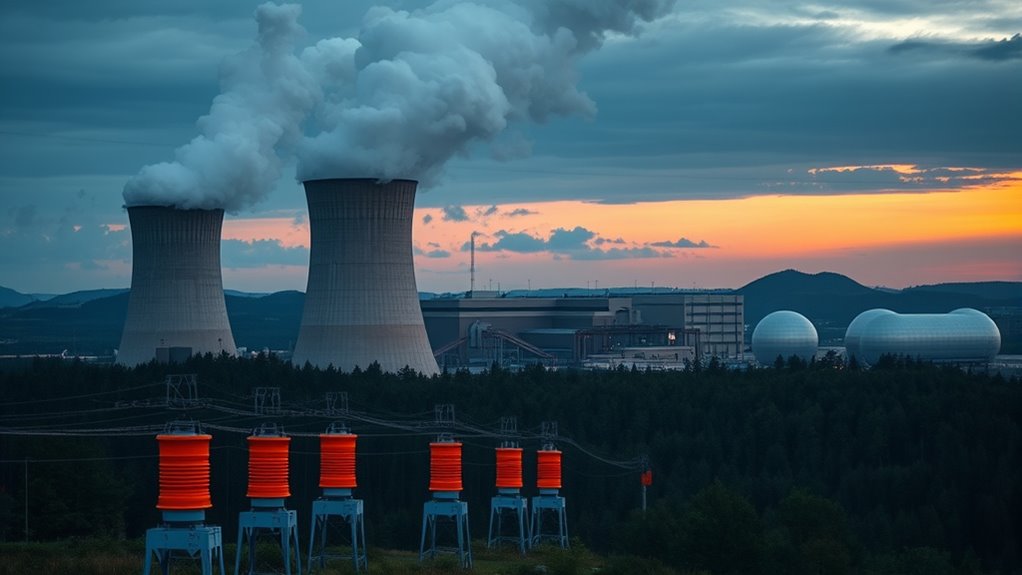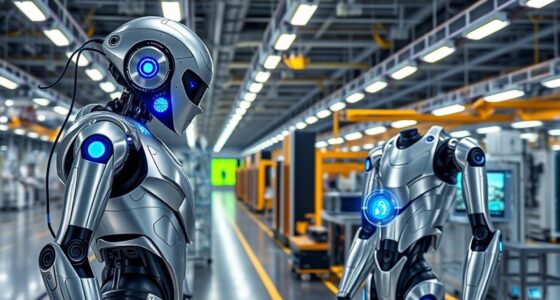As AI’s energy needs grow rapidly, big tech companies see nuclear power as a reliable, low-carbon solution to support their sustainability goals. Nuclear provides a steady energy supply, unlike intermittent renewables, and can scale to meet increasing demand. By combining nuclear with renewables and storage, they aim to reduce reliance on fossil fuels and lower environmental impact. If you’re interested, there’s more to uncover about how these energy strategies are shaping AI’s future.
Key Takeaways
- AI’s growing energy demands strain existing power grids, prompting tech companies to seek stable, low-carbon energy sources like nuclear.
- Nuclear power offers a reliable, large-scale energy supply that can complement intermittent renewables to meet AI’s high energy needs.
- Integrating nuclear energy reduces dependence on fossil fuels, lowering AI’s overall carbon footprint.
- Combining nuclear with renewable energy and storage enhances grid stability for AI infrastructure.
- Major tech firms are investing in nuclear solutions to ensure sustainable, scalable power for AI growth.

Artificial intelligence systems are consuming more energy than ever before, raising concerns about their environmental impact. As AI models grow larger and more complex, they demand significant power to train, run, and maintain. This surge in energy consumption prompts a closer look at how our energy systems can handle the increased load without further harming the planet. One solution gaining traction is renewable integration — harnessing sources like wind, solar, and hydro to supply clean energy to data centers and AI infrastructure. By blending renewables seamlessly into the grid, you can reduce reliance on fossil fuels and trim the carbon footprint associated with AI operations. However, renewables are intermittent, which makes energy storage a critical component. You need efficient energy storage options to ensure a steady power supply, especially when the sun isn’t shining or the wind isn’t blowing. Large-scale batteries, pumped hydro, and emerging storage technologies can help buffer fluctuations, making renewable energy a reliable backbone for AI workloads. energy storage solutions are essential for maintaining grid stability and maximizing renewable use.
The challenge lies in scaling these solutions fast enough to meet the soaring demand for AI processing. You might think about how energy storage can act as a buffer, storing excess renewable energy during peak production and discharging it when demand spikes. This not only supports renewable integration but also stabilizes the grid, preventing outages and reducing the need for fossil-fuel-based backup power. With better energy storage, you can run AI systems more sustainably, lowering greenhouse gas emissions and decreasing overall environmental impact. As tech companies recognize the urgency, they’re investing in renewable-powered data centers and innovative storage technologies. These efforts are aimed at creating a more resilient, eco-friendly infrastructure capable of supporting AI’s ever-growing appetite.
Meanwhile, nuclear power emerges as a compelling option for large-scale, low-carbon energy generation. Unlike intermittent renewables, nuclear offers a steady, reliable source of power that can scale with AI’s energy needs. Integrating nuclear into the energy mix could provide a consistent baseline, reducing dependence on fossil fuels and smoothing out the variability inherent in renewable sources. For you, this means a more stable energy supply, allowing AI systems to operate at full capacity without environmental guilt. The combined approach of renewable integration, energy storage, and nuclear power has the potential to transform how we power AI, making it more sustainable and less destructive to the planet. As you look toward the future, embracing these solutions will be essential to balance technological progress with environmental responsibility.
Frequently Asked Questions
How Does Ai’s Energy Use Compare to Traditional Data Centers?
You’ll find that AI’s energy use is generally higher than traditional data centers because of its complex processing needs. However, many are now exploring renewable alternatives and focusing on energy efficiency to reduce environmental impact. By optimizing algorithms and investing in cleaner energy sources, you can help make AI more sustainable. This shift aims to balance AI’s power demands with eco-friendly solutions, ensuring progress doesn’t come at the planet’s expense.
What Are the Environmental Impacts of Expanding Nuclear Power?
Expanding nuclear power can substantially reduce carbon emissions, but it also raises concerns about nuclear waste and ecological effects. Did you know that nuclear waste remains hazardous for thousands of years? This poses ecological risks if not properly managed. While nuclear power offers a low-carbon energy source, you should consider the environmental impacts of waste disposal and potential accidents that could harm ecosystems. Balancing energy needs with environmental safety remains vital.
Are There Safety Concerns With Increased Nuclear Energy Adoption?
You should be aware that increased nuclear energy adoption raises safety concerns, especially regarding nuclear safety and radioactive waste. While modern reactors have improved safety measures, risks of accidents still exist, and managing radioactive waste remains challenging. Proper regulation and advancements in reactor technology are essential to mitigate these risks. Staying informed about nuclear safety protocols can help you understand how these concerns are being addressed to ensure safer energy use.
How Quickly Can Nuclear Power Infrastructure Be Scaled for AI Needs?
You can expect nuclear power infrastructure to scale surprisingly fast, thanks to urgent needs and technological advances. But beware—nuclear proliferation worries and public perception fears can slow progress more than a snail on a treadmill. While some see nuclear as a quick fix, others fret about safety and waste. So, while the clock may tick quickly, social and political hurdles might make the timeline feel more like a slow crawl.
What Policies Are in Place to Regulate Nuclear Energy Development?
You should know that nuclear regulation is guided by established policy frameworks designed to guarantee safety and security. These policies often include licensing requirements, safety standards, and oversight agencies, like the Nuclear Regulatory Commission in the U.S. or similar bodies worldwide. These frameworks evolve with technological advances and public concerns, aiming to promote responsible development while balancing energy needs and safety.
Conclusion
As AI’s energy demands grow, you realize the need for sustainable solutions, for cleaner energy, for reliable power, and for innovation to meet the challenge. You see big tech turning to nuclear power, exploring new ways to harness its potential, to fuel progress, and to reduce emissions. You understand that balancing AI’s hunger with Earth’s health requires bold choices, strategic investments, and a shared commitment to a future where technology and sustainability go hand in hand.











